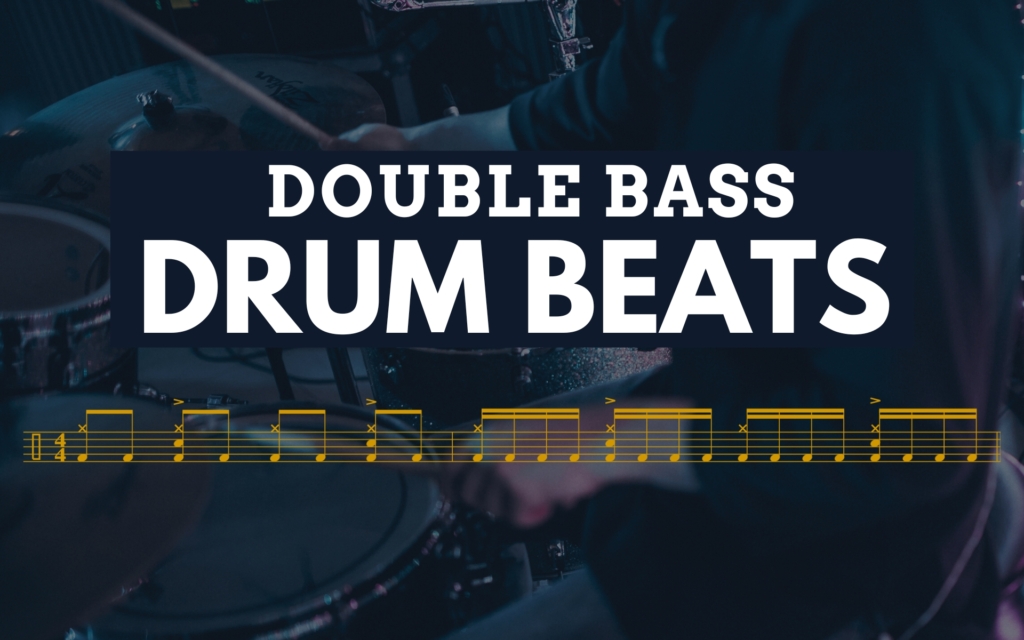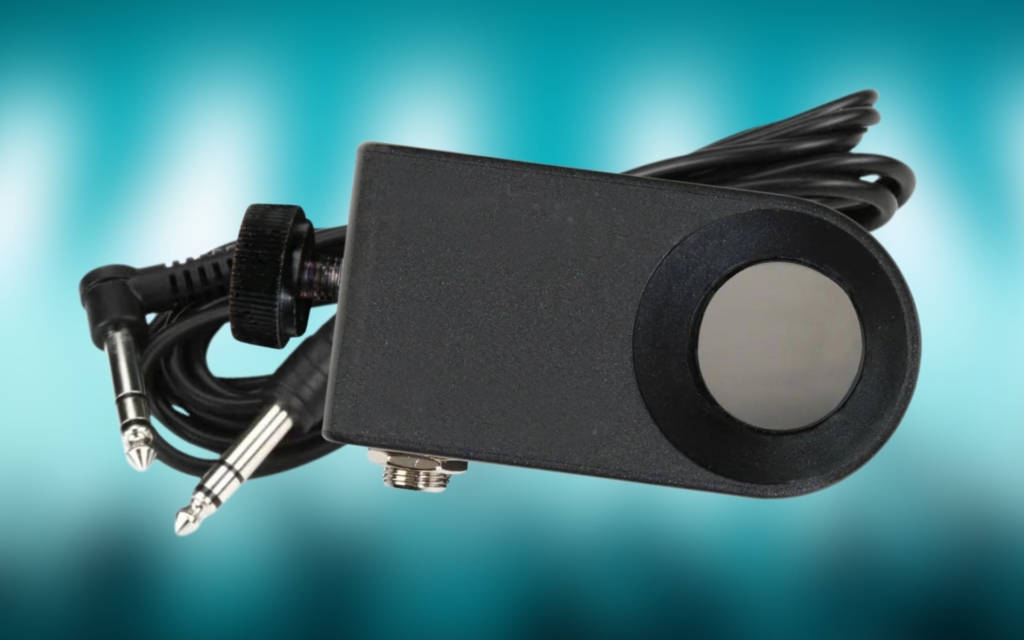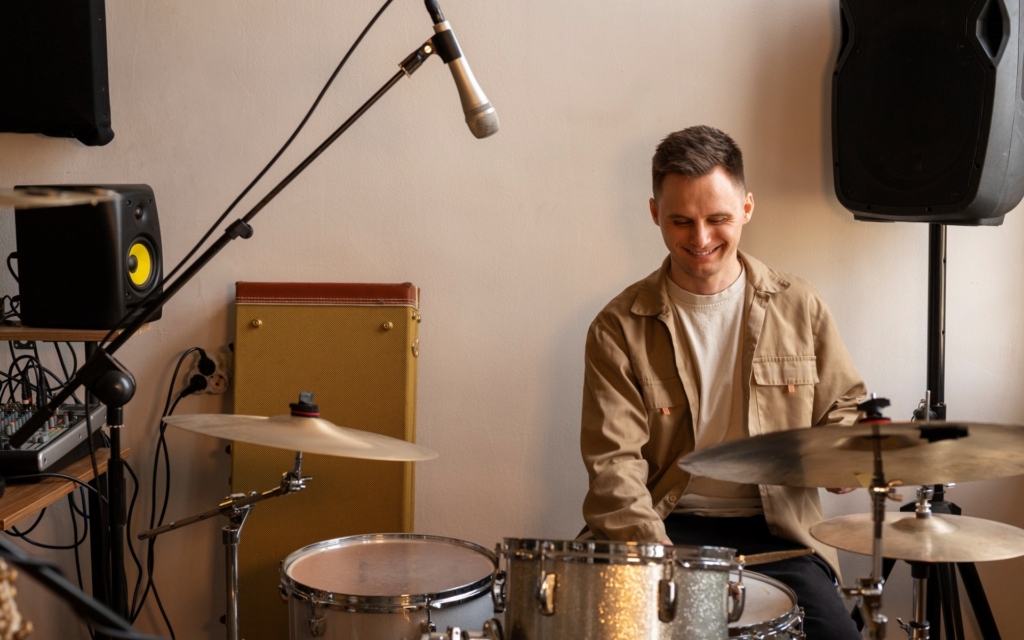There are several common drum beats in the music world that regularly get used throughout different songs. Learning how to play these on the drums will prepare you for any gigs that may come your way.
Some of them are easy, while others are tricky and take ages to master. All of them are instantly recognizable by seasoned musicians.
In this guide, I’ll show you what these drum beats are, and I’ll give short descriptions, along with notation and audio clips.
Contents
15 Popular Drum Beats
Basic Rock Beat
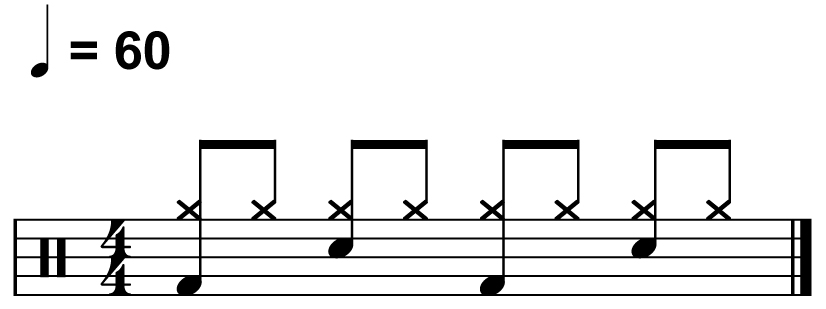
The basic rock beat is the most common drumming pattern you’ll ever hear. This is the first drum beat that everyone learns to play when they start drumming, and it’s the groove that seasoned professionals continue to play deep into their careers.
It’s the ultimate beat, as it can be used in thousands upon thousands of different songs.
To play it, you need to play consistent eighth notes on the hi-hat. You then play kick drums on beat one and three, and then you play snare drums on beat two and four.
Four on the Floor
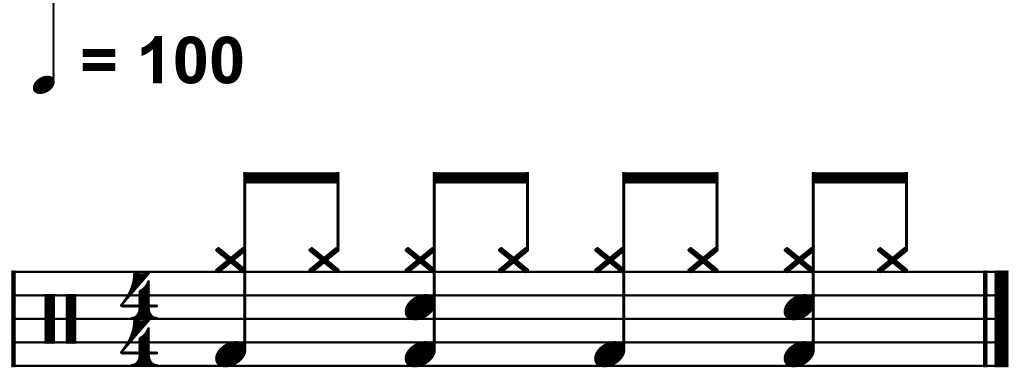
Four on the floor is another massively popular drum groove. This modern drum beat is almost used in as many songs as the basic rock one.
It’s a simple extension of that groove, as you just add two more kick drums into the mix. For this groove, you’re going to play your bass drum on all four counts of the bar.
Your hi-hat will be played on all the eighth notes, and the snare will be played on beats two and four. It may feel a bit weird to play a bass drum and snare drum at the same time, but you’ll get used to it quickly.
Funk Beat

Here’s a basic version of a popular funk drum beat. It incorporates quiet snare drum hits and an offbeat bass drum stroke.
You’ll play simple eighth notes on the hi-hat with your right hand, and then you’ll do a bit of interplay between your left hand on the snare drum and your right foot on the bass drum pedal.
Make sure to play those ghost notes as quietly as you can, as quiet ghost notes make stronger snare strokes pop.
Bossa Nova

A Bossa Nova is one of the simplest Latin grooves to learn, so it’s a good one to start with if you’re looking to get into Latin drumming.
People regularly relate this beat to hotel lounges and elevator music, but it has a strong history.
To play it, you need to keep playing eight notes on the hi-hat. Your bass drum foot will play a repeating ostinato, consistently hitting doubles throughout the bar.
While you keep those rhythms going, your left hand will play a repeating cross-stick rhythm on the snare drum. In the first bar, you play the snare three times. In the second bar, you play it twice.
Samba

The Samba is another popular Latin drum beat. It’s very similar to the Bossa Nova, so it helps if you can play the Bossa Nova before starting to learn this one.
The big difference is that a Samba is typically much faster. It’s also only one bar repeating, whereas a Bossa Nova is two repeating bars.
For this particular Samba groove, you’ll play a similar cross-stick pattern to the previous one on the Bossa. However, you’re going to play the final snare drum note a bit sooner.
Shuffle
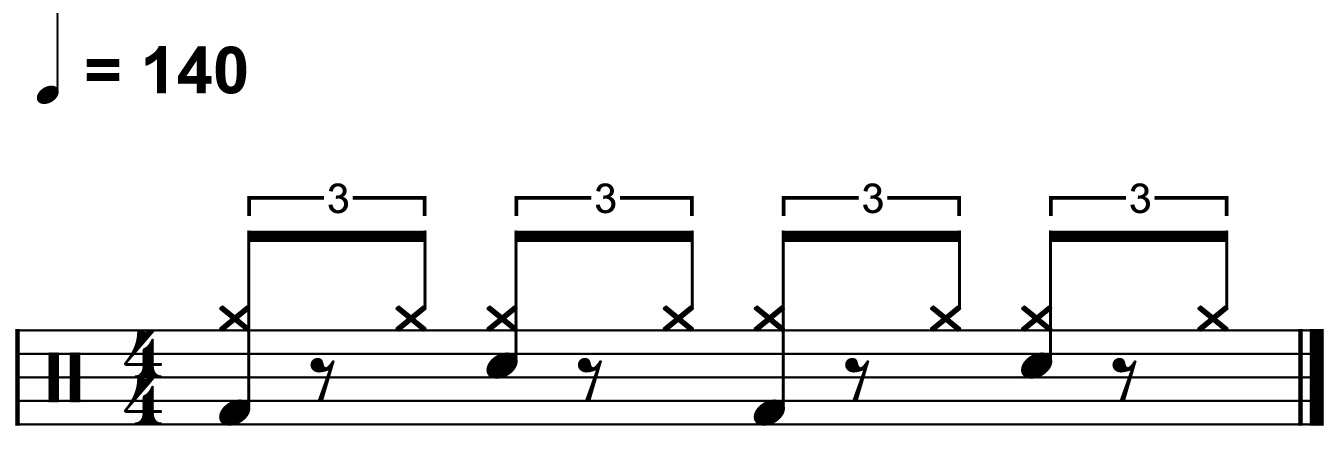
Shuffles are regularly used in blues, country, and rock music. They’re quite tricky to play on the drums, as you need to have great hand technique to be able to maintain the shuffle tempo.
To play this groove, you’re going to play eighth note triplets on the hi-hat, but you’re going to skip the middle triple note for each group of three. That will give you a swinging pattern.
You’ll then play your bass drum on beats one and three, and you’ll play your snare drum on beats two and four.
This beat is very similar to a basic rock beat, but you play it swung instead of straight.
Half Time Shuffle

Half-time shuffles are a different version of standard shuffles. The difference is that they’re stretched over two bars, and the main snare drum backbeat only lands on beat three.
Another common aspect of half-time shuffles is that they’re packed with ghost notes.
The Purdie Shuffle is the most popular version, and that’s what this particular half-time shuffle is based on. The trickiest part to play is landing the ghost note straight after the backbeat. Make sure you get it, though, as it makes the beat sound far groovier.
Disco Groove

This disco groove is another version of a four on the floor drum beat. The difference here is that you’re going to open the hi-hat on all the offbeats.
This gives the groove a bouncier feel, and it’s one that you commonly hear in disco music.
Disco drum beats will also be a lot quicker than the four on the floor one that we looked at earlier, as most disco music has high tempos.
Motown Drum Beat
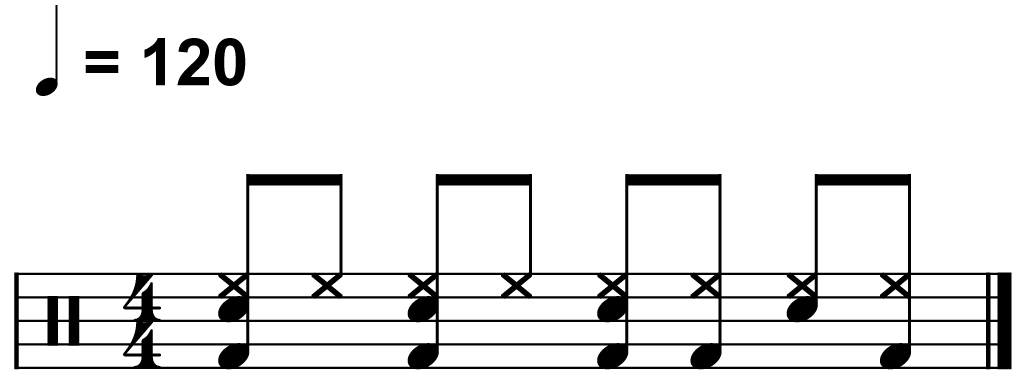
Motown was an incredibly huge movement and style of music that came out of the 20th century. While it’s not as popular today, musicians still commonly refer to certain musical pieces as Motown-inspired.
The Motown drum beat is one of those things, as this drum beat was first made popular in the Motown era.
To play this groove, you’re going to keep consistent eighth notes on the ride cymbal. You’ll then play your snare and kick drum together on all the quarter notes. The final touch is to add a few extra kick drum notes toward the end of the bar.
Swing Groove
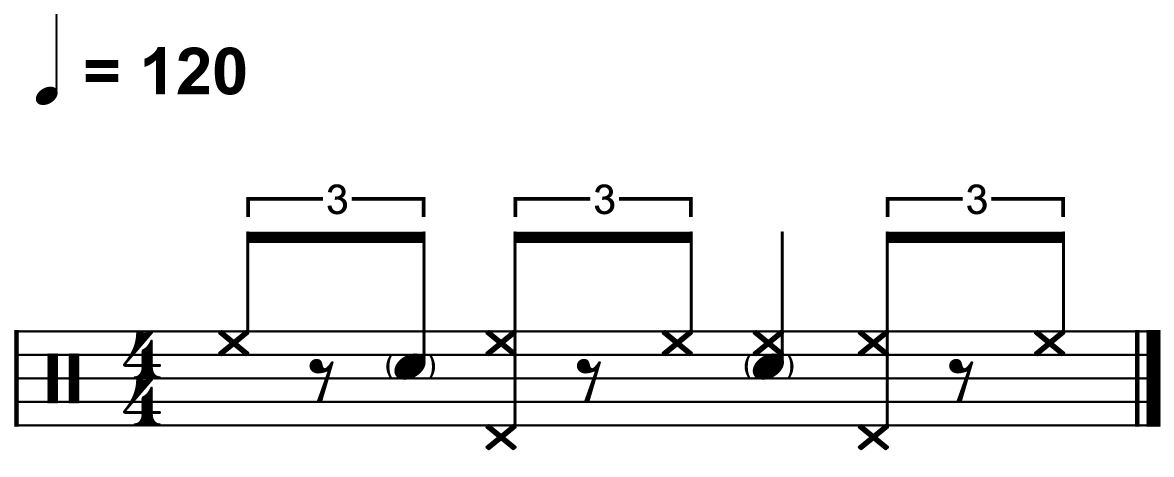
Jazz is an incredibly vast style of music, with most of it being very improvisational. However, swing grooves tend to be the building blocks of learning to play jazz, and a basic swing is always the first thing that jazz drummers learn.
In this simple swing groove, you’re going to play the common swing pattern on the ride cymbal. You’ll then play your hi-hat foot on beats two and four. That combination alone will sound good on countless jazz songs.
To spice the beat up a bit, you can play a few light snare drum notes. Just don’t play them too loudly, as you want your ride and hi-hat parts to be the center of attention.
Reggae Groove

This drum beat is called a reggae one drop. It’s referred to as that due to the bass drum and snare drum only landing once in the bar.
When you play this beat with reggae music, all the other instruments will accent that single drop part as well. You’ll then play the hi-hat to fill the rest of the bar.
Most reggae drum beats are based on this particular pattern. You’ll just start adding a few more notes here and there.
Pop Groove

This pop groove is a simple variation of the basic rock drum beat. The difference is that you play the bass drum on the “and” of three instead of on the downbeat.
I’ve called this a pop groove, as you’ll most commonly hear it being used in pop music. Some songs have slow tempos, while others are quite fast. This beat fits perfectly in all of them.
Train Drum Groove

Train drum beats are most commonly used in country music, but you’ll sometimes hear them in a few other styles like indie-folk and worship.
This groove has 16th notes all being played on the snare drum. There are a few accents to create the backbeat, and then the bass drum and hi-hat parts fill in to give it a bit of depth.
Swing in 3
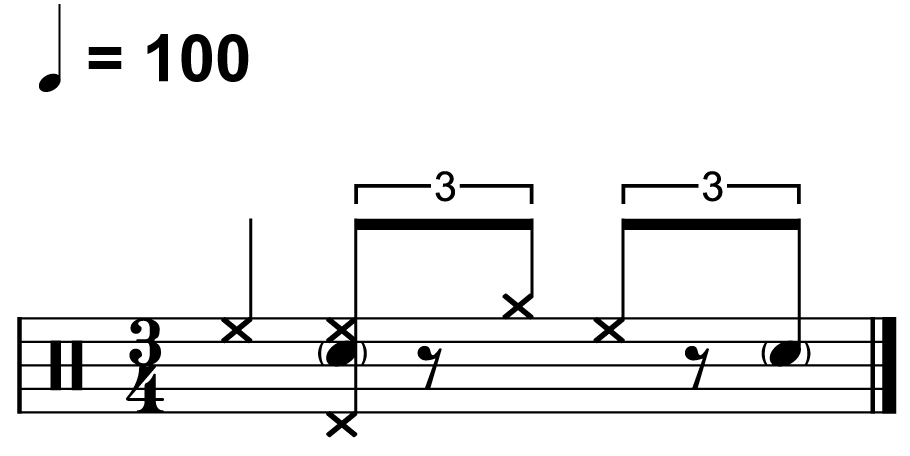
Here’s another common swing drum beat. With this one, you’re playing in bars of three instead of four. It just means that you only play the ride swing pattern once in each bar.
16th Note Groove

This final drum beat is a common 16th note groove. You need to use both your hands to play the alternating notes on the hi-hat.
You’ll then move your right hand over to the snare drum on beats two and four to create the backbeat.
You could also play a 16th note groove with one hand on the hi-hat, but this version allows you to play much quicker ones.
Conclusion
While those are popular drum rhythms, they just scratch the surface of what you can play in different musical styles.
Most of them are the first basic drum beats that you learn for particular styles. Once you know how to play those ones, you can use them as foundations to build on to play busier and more interesting drum riffs.
Remember to practice each one of these grooves with a metronome so that you solidify your timing. Once you’ve learned them, it’s a good idea to play them to music where you commonly hear those kinds of beats.
Good luck!


